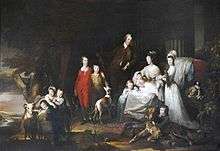Henry Dawkins

Henry Dawkins II (1728–1814) was a Jamaican plantation owner and Member of the Parliament of Great Britain (MP).
Background
William Dawkins acquired plantations in Jamaica, by grant, in the period 1669 to 1682. These descended to his grandsons James Dawkins I, and the sons of Henry Dawkins I, James Dawkins II and Henry Dawkins II, sons of Henry Dawkins I, all three being MPs. Both James I and James II left property in England to Henry II, who also inherited Jamaican properties from relatives, for an annual income of £40,000 to £50,000.[1]
Life
He was born 24 May 1728, the second surviving son of Henry Dawkins (1698–1744) of Clarendon, Jamaica, a sugar planter, and his wife, Elizabeth, daughter of Edward Pennant of Clarendon, chief justice of Jamaica; James Dawkins II, who died in 1757, was his elder brother. He studied at St Mary Hall, Oxford from 1745,[2][3]
From 1752 to 1758 Dawkins was a member of the assembly in Jamaica, and was then on the council to 1759. In 1760 he entered the Parliament of Great Britain as member for Southampton, holding the seat to 1768. He then was member for Chippenham, Hindon and Chippenham again, leaving Parliament finally in 1784, after a 24-year period when he had been M.P., considered a Tory and not to have spoke in the House of Commons, with only short breaks. He had been defeated at Salisbury, near his estate at Standlynch, in 1768. His son James succeeded him at Chippenham.[3] He was elected a Fellow of the Royal Society in 1778.[4]
Standlynch Park
Dawkins sold his brother's estate at Laverstoke in 1759.[5] In 1766, he bought Standlynch Park in Wiltshire (now called Trafalgar Park), from William Young, for £22,000.[6][7] The existing Standlynch House dated from the 1730s.[8] He had work done on the wings, by John Wood, the Younger, and on the portico by Nicholas Revett, an associate of James Dawkins through the Society of Dilettanti, to which Henry Dawkins also belonged.[9]
When Dawkins died in 1814, Standlynch Park was sold for £90,000 to William Nelson, 1st Earl Nelson. He put towards the purchase the money voted for his by Parliament in 1806.[1] He changed the name to Trafalgar House and Park.[10]
Family

Dawkins married in 1759, Lady Juliana Colyear, daughter of Charles Colyear, 2nd Earl of Portmore.[3] They had eight sons and four daughters. The sons were:[11]
- James, Member of Parliament, married in 1785 Hannah Phipps, and secondly Maria Forbes[12]
- George Hay, Member of Parliament, married in 1807 Sophia Mary Maude, daughter of Cornwallis Maude, 1st Viscount Hawarden, and in 1814 Elizabeth, daughter of William Henry Bouverie[13]
- Henry (1765–1852), Member of Parliament for Boroughbridge, married in 1788 Augusta, daughter of Sir Henry Clinton, father of Henry Dawkins (1788–1864), also Member of Parliament for Boroughbridge[14]
- William, died an infant
- Richard, married Jane Catherine Long, daughter of Edward Long and Elizabeth Masters. Father of James Dawkins I
- Edward, who took holy orders
- Charles, in the Grenadier Guards
- John (1774–1844), Fellow of All Souls College, Oxford and barrister[15]
The daughters were:[11]
- Augusta, died an infant
- Elizabeth, married in 1795 William Ronke Leeds Sergeantson[16] or William Rookes Leedes Serjeantson[17]
- Juliana, died unmarried in 1847
- Susanna, married in 1804 Sir Edward Dodsworth, 2nd Baronet.[18]
Notes
- 1 2 H. J. Habakkuk (1994). Marriage, Debt, and the Estates System: English Landownership, 1650-1950. Clarendon Press. pp. 455–6. ISBN 978-0-19-820398-8.
- ↑ Parker, M. St John. "Dawkins, James". Oxford Dictionary of National Biography (online ed.). Oxford University Press. doi:10.1093/ref:odnb/7338. (Subscription or UK public library membership required.)
- 1 2 3 "Dawkins, Henry (1728–1814), of Over Norton, Oxon. and Standlynch, Wilts., History of Parliament Online". Retrieved 10 June 2016.
- ↑ Thomas Thomson (1812). History of the Royal Society, from Its Institution to the End of the 18th Century. Baldwin. p. lvii.
- ↑ George Frederick Prosser (1833). Select Illustrations of Hampshire. J. & A. Arch. p. 154.
- ↑ "History of Trafalgar Park Wiltshire". Retrieved 10 June 2016.
- ↑ H. J. Habakkuk (1994). Marriage, Debt, and the Estates System: English Landownership, 1650-1950. Clarendon Press. p. 456. ISBN 978-0-19-820398-8.
- ↑ Christopher Christie (2000). The British Country House in the Eighteenth Century. Manchester University Press. pp. 47–. ISBN 978-0-7190-4725-1.
- ↑ Nikolaus Pevsner; Bridget Cherry (1975). Wiltshire. Yale University Press. p. 529. ISBN 978-0-300-09659-0.
- ↑ Pocock, Tom. "Nelson, William". Oxford Dictionary of National Biography (online ed.). Oxford University Press. doi:10.1093/ref:odnb/19888. (Subscription or UK public library membership required.)
- 1 2 Sir Bernard Burke (1871). A Genealogical and Heraldic History of the Landed Gentry of Great Britain & Ireland. Harrison. p. 334.
- ↑ "Dawkins, James (1760–1843), of Standlynch, Wilts., History of Parliament Online". Retrieved 10 June 2016.
- ↑ "Dawkins Pennant, George Hay (1764–1840), of Penrhyn Castle, Caern., History of Parliament Online". Retrieved 10 June 2016.
- ↑ "Dawkins, Henry (1765–1852), of Over Norton, Oxon., History of Parliament Online". Retrieved 10 June 2016.
- ↑ "John Dawkins (1774–1844), Summary of Individual, Legacies of British Slave-ownership". Retrieved 10 June 2016.
- ↑ The Lady's Magazine Or Entertaining Companion for the Fair Sex: Appropriated Solely to Their Use and Amusement. Baldwin, Cradock & Joy. 1795. p. 296.
- ↑ E. Walford (1882). The county families of the United Kingdom. Рипол Классик. p. 576. ISBN 978-5-87194-361-8.
- ↑ John Burke (1833). A General and Heraldic Dictionary of the Peerage and Baronetage of the British Empire. H. Colburn. p. 369.